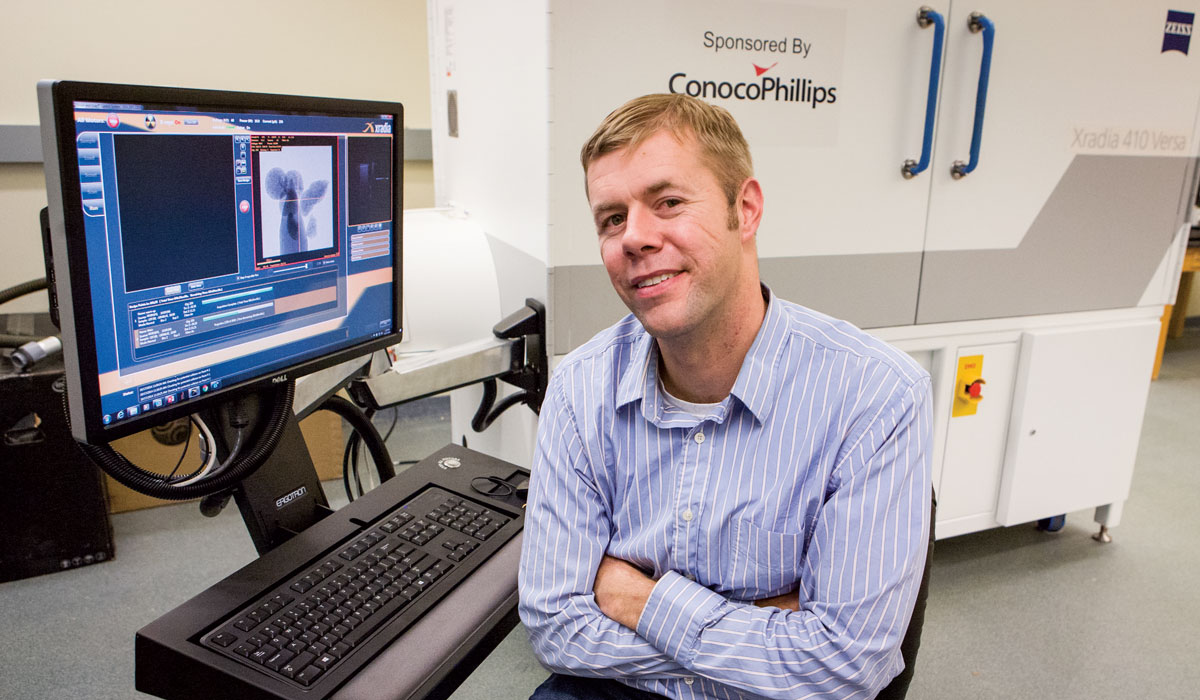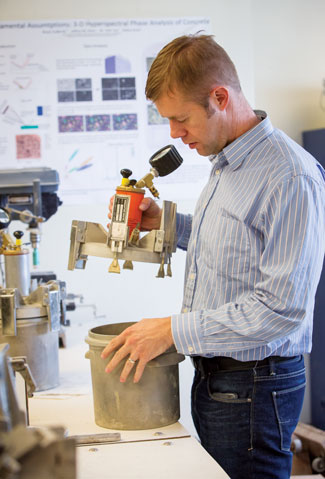Concrete Studies
Friday, November 6, 2015

Concrete is the second most-used commodity in the world, topped only by one of its primary components — water. At five cents per pound, concrete is the most inexpensive, longest-lasting material on the planet.
For seven years, Tyler Ley, OSU associate professor and Williams Foundation professor of civil and environmental engineering, has performed world-class concrete research and implemented practical uses of his findings in Oklahoma and surrounding states. His efforts have led to the creation of equipment and establishment of nationwide standards.
Ley and his research team lead a variety of projects united by the theme of improving concrete. From 3-D images of components interacting to new concrete mixtures currently used in Texas, Ley and his colleagues are changing the future of this diverse material.
Nanoscale perspective
Ley’s lab is one of a few that can view materials at the nano scale, showing 3-D images where each point is 30 nanometers in size, and a sample is 1/5 the size of a hair. This gives the research team the ability to see how the cement particles in concrete react and form their internal structure.
Ley says control of the microstructure allows for the control of large-scale properties, an elemental piece of his goal to alter the basics of concrete to improve its ability to withstand stress and reduce its CO2 emissions during production.
Through a partnership with Princeton University, the University of California in Santa Barbara, the University of Bremen and the National Institute of Standards and Technology (NIST), Ley’s research team is imaging the reaction of cement by producing three-dimensional structure and chemistry images of their results for use in models created at Princeton and NIST. The work is being done at the Center for Nano Materials at Argonne National Laboratory, just outside Chicago. The goal is to provide computer models for engineers to better predict the reaction and innovative changes to concrete on a global scale.
“If we could find simple ways to improve the cost, carbon footprint or durability of concrete, the benefits to society would be huge,” says Ley. “Successfully making tweaks to the basics of cement has the potential for multibillion-dollar savings.”
While Ley’s team is making significant headway in these areas, he has already brought several research projects to fruition through implementation.
Impactful results
Ley’s work has changed the landscape for concrete and concrete-related issues in Oklahoma and several other states. Together with partnerships within the College of Engineering, Architecture and Technology and others throughout OSU, Ley has developed new concrete mixtures and testing standards used internationally.

Applied research from Ley’s lab can be found in roadways, bridges and concrete structures across Oklahoma and Texas. Most recently, Ley’s team designed a new concrete mixture that recognizes rock sizes, allowing companies to save on the cement used while producing concrete. Savings from this development are moderately estimated at $4 million per year in total cost and 400 homes’ worth of energy.
Another of Ley’s inventions to streamline the concrete industry is the Super Air Meter (SAM). The device detects the size distribution of bubbles in a concrete mixture before it has hardened. This gives producers time to adjust the mixture before pouring.
Ley says soap is added to concrete because small bubbles are necessary to create space for water as it freezes due to outside elements, citing what happens to a soda in a freezer as a demonstration of what freezing temperatures can do to concrete that does not have the correct size air bubbles.
The SAM is used in 16 states, and 12 of those are currently funding further research, including a partnership between Purdue University and OSU to investigate new specifications. The results of this project have already led to a pending American Association of State Highway and Transportation Officials (ASHTO) test method that, if instituted, will alter concrete processes across the country.
Future generations
Whether teaching in the classroom or leading projects in a lab, Ley is a role model and innovative leader in his field and on campus. Several graduate students work alongside him, and his passion makes a meaningful impact on those around him, from inspiring students to pursue the area to including them in important research findings.
Doctoral candidate Marllon Cook comes from a long line of concrete contractors. He came to OSU ready to study anything but the same line of work he grew up around, but after a class with Ley, Cook soon found himself in classrooms and labs learning and researching concrete.
“Dr. Ley has built a high-productivity research environment that allows the research assistants to learn cutting-edge technology in the industry,” says Cook. “He makes his students not only think outside the box, but question the box’s own existence.”
Once Ley has students as passionate about concrete as he is, he fosters the learning atmosphere through mentorship.
Second-year graduate student David Welchel says Ley provides guidance for any problems and has taught him a great deal. Welchel has been a part of the new testing standards soon to be implemented and will use his experience as he pursues his career.
Whether standing on a back patio or driving across a bridge, one can find Ley’s work reflected in countless places. His research is taking concrete into the future and improving processes while encouraging the next generation of concrete researchers and industry professionals to see the field’s importance. Ley is changing the future of concrete, the lives of students and the partnerships of OSU.
